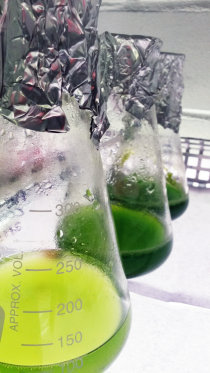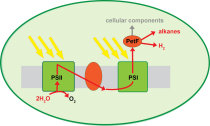
An international research team wants to create semi-artificial chloroplasts for the manufacture of biotechnologically relevant products. For this purpose, they aim to modify the photosynthetic process of natural chloroplasts. The EU is funding the undertaking with 1.2 million euros for the time period of three years, as part of “ERASynBio”, an initiative striving to promote synthetic biology in Europe. Prof Dr Thomas Happe from the work group Photobiotechnology at the Ruhr-Universität Bochum is coordinating the “Sun2Chem” project.
Customised photosynthesis
During photosynthesis, plants use solar energy to convert water and carbon dioxide into chemical energy and biomass. They apply this process in order to generate biomass, i.e. new cellular building blocks. Photosynthesis is relevant, for example, for the production of biofuels. Following the same principle, it would also be possible to generate substances that are building-blocks for the industrial synthesis of drugs and other chemicals, such as alkanes. The researchers want to customise the semi-artificial chloroplasts in such a way that they would primarily generate products that are biotechnologically relevant and commercially viable. For this purpose, the RUB team headed by Thomas Happe collaborates with colleagues from the French research centre “CEA Cadarache” and the University of Oxford, UK.
Modifying the chloroplasts’ genetic make-up

In natural chloroplasts, special protein complexes, so-called photosystems, absorb sunlight and generate high-energy electrons. A number of other proteins subsequently transport these electrons, until their energy is eventually utilised in reactions that result in the creation of new cellular building blocks. The “Sun2Chem” project is striving to alter the genetic system of natural chloroplasts using synthetic biology tools. The constructed semi-artificial system would therefore contain modified proteins. Not only would this render the electron transport chain more efficient, it could also result in a new reaction where desirable products are generated, rather than cellular buildings blocks.
Contact
Prof Dr Thomas Happe
AG Photobiotechnology
Faculty of Biology and Biotechnology at the Ruhr-Universität
44780 Bochum, Germany
phone: +49/234/32-27026
email: thomas.happe@rub.de
Source
Ruhr-Universität Bochum, press release, 2015-03-05.
Supplier
CEA Cadarache
European Union
Ruhr-Universität Bochum
University of Oxford
Share
Renewable Carbon News – Daily Newsletter
Subscribe to our daily email newsletter – the world's leading newsletter on renewable materials and chemicals










